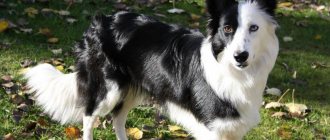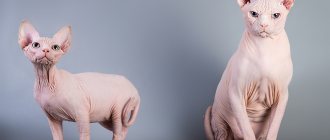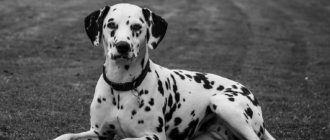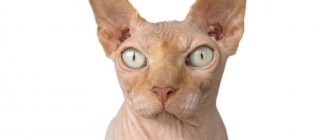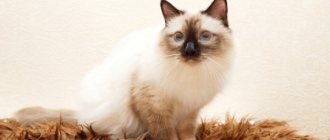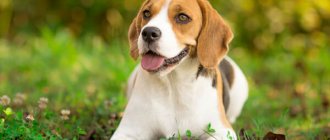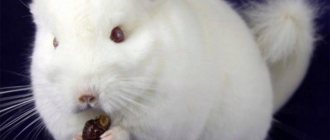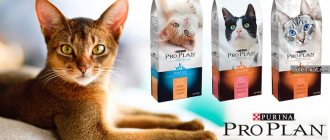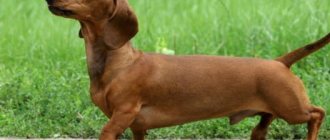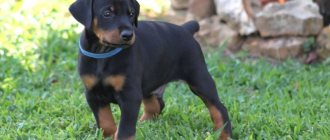The British are the aristocrats of the cat world. Looking at them brings incredible aesthetic pleasure. If you desperately want a cat that will add comfort and warmth to your home, but are afraid that you won't have enough time for a pet, the British is the right breed.
British cream cat
Beautiful, or better yet, luxurious, independent and charming animals with a calm disposition. What's the catch? It would be a lie to say that there is none. Before purchasing a plush kitten, it is better to learn in more detail some points about the character of the British. Then, if you decide that such a pet is ideal for your temperament, do some research on hereditary diseases in the British.
The British cat breed is exactly the option when the miser pays twice. Advertising sites are full of inexpensive kittens. On the other hand, the price for a kitten from a nursery can reach 15-50 thousand rubles. Where does such a range of prices come from and is there any point in overpaying? You need to figure this out on your own. After all, breeders of any price category have their own selfish interest - to sell kittens, so all their words and statements must be considered from a critical point of view.
Author of the article: Olga Shiltsova, practicing veterinarian, author of the books “Dachshund of Fate” and “Tails of Fortune”
Origin story
According to one version, British cats were brought by Roman legionnaires about 2000 years ago during the development of the islands of Great Britain. Another version interprets the French origin of this breed. There is no reliable data on who exactly brought these animals to the islands. History describes large gray cats among both Roman and French sailors, who were kept on ships to exterminate rodents. One way or another, the animals ended up in a separate territory, which allowed them to form their unique appearance. The damp and cold climate of England played a significant role in the evolution of the British breed. Due to constant winds and dampness, the wool became dense and thick. Hunting rodents has formed a strong body with developed muscles. Until the end of the 19th century, these animals were perceived as ordinary domestic cats.
In 1871, Harrison Weir organized the world's first cat show at the Crystal Palace in London . He proposed standardizing the breeds and introducing a point grading system. This time is considered the birth of the shorthaired breed . Harrison noticed that “aboriginal British” cats are different from others, they are larger, more massive, with special hair. In 1880, the first performance of these cats took place in London. In 1889, the first purebred shorthair cat was recognized. It was a white cat. In 1898, the first pedigree was issued. Until the beginning of the 20th century, selection did not divide shorthaired cats into British and European. The selection of representatives of the British breed began in the 30s of the 20th century. The official division of short-haired cats into British and European cats occurred in 1966.
The years of the First and Second World Wars affected the development of many breeds in Europe. The sharp decline in the number of British cats during the war and post-war times forced breeders to resort to interbreed matings to increase the population. Persian, exotic, chartreuse, Russian blue, European and American shorthairs were used in the breeding work. Thanks to the influx of new blood, by the beginning of the 20th century the British breed had several colors (solid, smoky, tabby, silver), although initially shorthaired cats in England were predominantly tabby. Crossing with the Persian breed quickly restored the population of large, strong animals, but fixed the gene for coat length, which gave a long-haired variation of the British breed, which is not recognized by all systems.
felinological system officially recognized the British Shorthair breed in 1980 as an independent breed with a ban on interbreed matings.
Features of temperament
The character of these animals can be said to be truly English. They are calm, behave with dignity, and have good manners. From an early age, they get used to the litter box without any problems, do not wake up their owners, and wait for people to wake up. These cats build excellent relationships with everyone who lives with them under the same roof.
Children do not irritate Golden Chinchillas much, even if they sometimes bother them with too intrusive communication, in this case the animal simply goes to another place, and there is no question of any bites or scratches.
The basis of the temperament of these animals is clearly expressed in signs of independence. The cat does not tolerate attacks on its freedom, desire for privacy and dignity. One of their characteristic traits can also be called stubbornness.
Appearance
A strong, large, powerful British cat is difficult to recognize. The characteristic appearance sets this breed apart from other cats.
The British Shorthair and Longhair breeds have a strong, broad-boned, muscular, compact, well-balanced, stocky, medium to large sized body. The weight of adult cats is 4-6 kg, males - 5-8 kg. The formation of the backbone and growth of the British is long, formed by 2-3 years. The chest is wide. The back is straight and short. The shoulders are broad and massive, as are the hips. The limbs are short and strong with rounded paws. The tail is straight, short, thick at the base and rounded at the tip. In general, the impression of everything is large, compact and round.
The British breed's head attracts attention, distinguishing it from other breeds. Round, large with a wide skull . The ears are small, set wide and low, rounded at the tips, well furred on the outside. In profile, the rounded forehead “cup” turns into a straight, short, wide nose with a noticeable transition. The muzzle is round with full cheeks. Cheekiness is a distinctive feature of the British breed. Looking at the animal, one gets the impression of a smile. The cheeks are more developed in cats; cats have a less pronounced “girlish oval”. The chin is strong, smooth, and the nose forms a vertical line. The eyes are set wide, large, round, wide open. Eye color varies from honey, orange, yellow to blue and green depending on the color. The cheekbones are wide. The neck is short, thick, powerful.
The British Shorthair breed has a short, dense (thick) coat that does not lie close to the body, is not too soft, and is of equal length throughout the entire body (average length is 2.4 mm), with a well-developed undercoat and a fine texture that creates a feeling of “plushness .
Representatives of the long-haired variety have medium-length, straight hair with good undercoat and dry guard hair. The collar and panties are developed, the tail pubescence is long and luxurious. White and color point colors are not recognized in the British Longhair breed .
Diet
Like most other breeds of domestic cats, the Golden Chinchilla can eat food both in its natural form and ready-made factory-produced food.
If the owner chooses a natural type of feeding for his pet, the cat's diet should include: fish, meat, dairy products, butter, cereals and vegetables.
Meat ingredients of the menu: chicken, rabbit, turkey should be given raw, cut into small pieces and pre-treated in boiling water. Fish should not be present in the diet too often, once or twice a week. It would be better if it were sea.
As for dairy products, they should also not be abused. Once or twice a week should be enough. Fermented milk is healthier for cats; it is better to give kefir rather than milk. Read whether cats can drink milk in a separate article.
When choosing ready-made food, it is necessary to take into account the physiological characteristics of the animal, namely factors such as weight, age, health, tendency to overeat, pregnancy. You need to feed your pet two to three times a day. Also, do not forget to add vitamins and minerals to the diet (with natural feeding, good quality ready-made food already contains all the necessary vitamins).
Colors
There are more than 200 colors . Such diversity was formed during the periods of formation and revival of the British breed. Color selection continues to this day with the constant development of the breed.
Color assessment includes coat color, pattern, eye color, paw pad color and nose color.
Solid colors
Uniform color throughout the body. Solid colors do not allow spots, shades, white hairs or patterns . The coat is thick, short, and every hair is evenly colored from root to tip. The eyes are only orange, yellow, amber, copper, honey. For white solids, not only yellow eye color is possible, blue or odd-eyed is also acceptable. There are 9 solid colors :
- Black(n)
- Blue (a)
- Chocolate (b)
- Lilac (c)
- Red (d)
- Cream (e)
- White (w)
- Cinnamon (o)
- Faun (p)
Tortoiseshell colors (Tortoise, Tortoiseshell, Turtle)
A combination of genetically black and red colors. Only cats have this coloring . With chromosomal mutations, cats with trisomy may be tortoiseshell, but they are unable to reproduce. The eyes are always yellow (gold, copper, orange). The coat is thick and dense. “Turtle” is a unique color for breeding, since these cats produce a wide range of colors in their offspring.
- Black tortoiseshell (f)
- Blue-cream tortoiseshell (g)
- Chocolate cream tortoiseshell (h)
- Lilac-cream tortoiseshell (j)
Patterned or tabby colors (Tabby).
There is a pattern against the background of the main color. There are three tabby colors : marbled (classic), brindle (mackerel), spotted (spotted). What unites this group is the color of the head. All of them have the features of a tabby - the outline of the nose, eyes, a “scarab” on the top of the head, the letter “M” on the forehead . Eye color can be any in accordance with the color.
- Marble color (code 22) – a clear pattern in the form of wide lines. Large stripes run along the back from the withers to the tail. Several necklaces are attached to the neck. A “butterfly” pattern can be formed on the shoulder blades and curls can be located on the sides. There are 2-3 wide rings on the tail.
- Brindle color (code 23) - stripes are narrower, starting from the center line on the back and descending in narrow stripes on the sides. The necklaces on the neck are thinner, the tail is striped.
- Spotted color (code 24) – against a lighter background of the main color, clear contrasting spots are evenly located throughout the body. They can be round, oblong, or in the form of rosettes. There are spots on the limbs and preferably on the tail (open rings are acceptable).
Tipped colors (tipping, tipping)
This is a group of colors in which the hair has two or several zones of coloring (necessarily light at the root and dark towards the tip). There are two types of tipping: with and without silver (gold).
Silver tipped colors (s is added to the encoding):
- Smoky color (smoke). British smoke-colored cats have short, thick, coarse hair, each hair of which is painted 2/3 pure silver (almost white) from the root, including the undercoat. The remaining 1/3 of the hair towards the tip is colored in the main color (black, blue, red, etc.). The eyes are necessarily copper or orange. The nose and paw pads correspond to the color of the main color. Smoky is always a solid color and has no pattern.
- Shaded color (shaded, 11). 1/6 of the hair at the tip is dyed in the main color, the rest is silver. British cats have green or bluish-green eyes. Orange or copper eyes are possible - this color is called Pewter, with the obligatory indication of the eye color coding. The nose and paw pads correspond to the color of the main color. Red, cream, tortoiseshell shaded colors are called Cameo.
- Veiled color (shell, 12). 1/8 of the hair at the tip is dyed, the rest is silver. Chinchillas have green eyes. The nose and paw pads correspond to the color of the main color. The first chinchilla was bred in 1970 by Norman Winder in England after crossing a Persian chinchilla and a British shorthair. In 1973, it was exhibited for the first time at a cat show, where the breed was named British Black with Tipping. The color was officially recognized in England in 1980. Red, cream, tortoiseshell veiled colors are called Cameo.
Golden tipped colors (y is added to the encoding):
- By analogy with silver colors, golden Britons can be shaded, when 1/6 of the hair is dyed at the tip, or veiled (1/8 of the hair). The main background is from pale apricot to dark brick with transitions to black. The nose is brick-colored, the paw pads are black or dark brown. The eyes are only green.
- Shaded and veiled colors are colors that seem to be coated. Looking at these cats, it seems as if the animal was sprinkled with black powder on top (or another color depending on the main color). They do not have closed rings on the neck and limbs, and there should be no residual pattern. A dark outline of the nose and eyes is required.
Color point colors
This group of colors is recognized only in the British Shorthair variety, not in the Longhair variety. Color-points have a lightened body and darker areas - points (areas with low body temperature - muzzle, tail, ears, limbs, scrotum). Like solid colors, they are distinguished: seal-point - black, blue-point - blue, chocolate-point - chocolate, lilac-point - lilac, red-point - red, cream-point - cream. Patterned tabby color points are not divided into classic ones, since the pattern is quite blurred. They are combined into the links-point color. The eye color of British pointing cats is only blue .
Bicolor colors
British shorthair and longhair breeds have all possible combinations of white and any main color - the bicolor group. Based on the area of white color from maximum to minimum, Vanov, Harlequins, and Bicolors are distinguished.
- Van has the maximum amount of white. Completely white body and limbs. Only the tail and the “cap” on the head are colored in the form of one or two separate spots (ideally), always affecting one ear.
- Harlequin. A fifth of the surface of the body is colored, the rest is white. The tail, the “cap” on the head with the obligatory inclusion of one ear, and spots on the back and/or sides must be colored. A white collar is required.
- Bicolor. Half of the entire surface of the body has a basic color and can be located in one continuous area or have an island appearance. For bicolors, the placement of white is mandatory on the muzzle in the form of an inverted “V”, on the chest and lower part of the body, on the hips and legs in the form of “slippers”. A white collar is also desirable.
The British breed is not allowed to have white medallions or white paws.
Health
Today, several very real versions of the origins of the British with the Golden Chinchilla color have the right to exist. Some of them report that this coloring was first recreated by British felinologist-breeders, while others indicate that American breeders and scientists participated in the development of the color isomorph.
From all these various theories about the origin of the unique color of the traditional English breed, the conclusion remains that the long-term and painstaking work of breeders has made it possible to obtain a truly luxurious shade of wool, which evokes the constant admiration of people.
What is important is that as a result of many, sometimes inbreeding, crossings, Scottish and British Golden Chinchillas have maintained excellent health and immune systems, without losing their gentle temperament.
Character
The British breed is known for its balanced, aristocratic, intelligent character. They are quite independent and get along with people and other animals. Little curious. When guests come to the house, they try to hide in a secluded place in order to avoid unnecessary attention to their person.
They are not inclined to show aggression and are patient. They are trusting and attached to their owner, prefer to be close to him at a distance, but do not particularly like to be held. The British breed represents the ideal unobtrusive companion with a phlegmatic and calm temperament. This is a cat that is “on its own”, not fussy, measured, and a little talkative. Adult animals moderately love to play, are more lazy and prefer to sleep than run around the apartment. The British are smart, stubborn and calm, but touchy. Having offended your pet, you will have to win his favor with affection and attention.
Reviews from British cat owners
“My Churchill behaves like a true aristocrat; one can envy his restraint. He tolerates nail trimming and brushing, never meows over trifles, but purrs and purrs so that you can hear him from everywhere. We joke that this is the ringtone of our house. Although he is an independent man, he always meets and accompanies him to work. When he wants to be pampered, he has to put everything aside and scratch and stroke. Smart as a person. Always looks straight into the eyes. Adored beyond belief!”
“Sir Tyson is the most beloved member of the family. But he can’t be picked up, he can’t lie on his lap, he can’t sleep on the floor - only on his personal chair. He eats the same brand of food and has never stolen from the table. Talking to us. When he is being petted before bed, we pay attention to him while he is in the mood.”
“When you return from work, the cat appears slowly, almost piecemeal, like the Cheshire cat. He sits down and looks - they say, where they were hanging around and how long to stay with us. Slowly washes off. He may freeze with his paw raised - he is thinking about something. He never asks for food. At most he can sit by the bowl, doesn’t look at you, just a living reproach. If you catch him eating something from the table, he doesn’t run away, doesn’t scream - sorry, it’s not me, the devil has confused him. Oh no! He simply looks reproachfully at where the equipment is and why he is forced to eat in such poor conditions. Mars sheds constantly, tolerates a dacha, but is not enthusiastic about fresh air.”
“They allow themselves to be loved - these words say it all. And you will be happy that you were allowed to live with these celestials."
“Zero attention to pussy-kiss-kiss, he won’t even turn an ear. It’s worth calling by name - immediately interrogative Mr-r-r-r, no matter where she is at that moment.”
“I had a British guy. I still remember with irritation how contempt for bipeds was imbued with his every glance. The self-esteem is simply exorbitant. I described the entire apartment, the stench could not be removed by any means.”
Care and maintenance
Unobtrusive, balanced British cats are easy to care for . Perhaps this is one of the most unpretentious breeds. The main task of the future owner is to maintain healthy coat quality, care for the ears and eyes. Due to the dense, thick undercoat, regular brushing is necessary, and daily during the shedding period.
Periodically you need to wash the animal using professional cosmetics. Regular grooming helps prevent the development of bezoars (wool stones in the animal’s digestive system), since the animal constantly licks itself, and wool entering the digestive tract can cause inflammation.
The British breed is moderate in its physical activity, therefore it is prone to obesity. A balanced diet, feeding regimen and regular exercise will allow the animal to be healthy and in great shape. Provide your pet with toys, a scratching post, and a climbing and play area.
Purchasing a kitten
The cost of each unique golden kitten in the nursery depends on many characteristics: gender, type of ears (fold or straight), color, purpose of purchase (show, pet or breeding), health status, availability of genetic tests of parents, title and fame of ancestors, pedigree .
Golden British and Scottish Chinchillas with breeding rights and purchased for participation in exhibitions, that is, breeding and show classes, are very expensive, from two to ten thousand dollars, since high-quality animals of this color are very rare.
Golden Chinchillas, which are purchased as pets, without a pedigree or pet class, are several times cheaper.
Source
What to do if your eyes are watery?
Most infectious diseases can lead to serious damage to the visual organs. In some cases, for example, with Pseudomonas aeruginosa, the clock is ticking: literally within a day the organ can “burn out.” If you start treatment on time, you can do without complications.
If the process is external and it is just beginning, it can be stopped by simply washing it with clean boiled water or chamomile decoction in order to wash away excess pathogenic microflora. This can be first aid if there is no veterinary clinic nearby.
A veterinarian has many diagnostic and treatment methods at his disposal. It can be carried out with the help of medications if the process is infectious. For example, with an external bacterial process, Floxal ointment works well, but with viral lesions, a completely different therapy is prescribed, because Antibiotics are useless for viruses. If there is a blockage in the nasolacrimal duct, try to rinse it. In some cases, surgery is indicated. In any case, the veterinarian must offer a solution.
It’s better not to mess around with self-diagnosis and treatment. It is the cases where the cat was treated independently that pose the greatest difficulty even for a good veterinarian. Sometimes the owners turn to the doctor, but he can only state that the animal has already become blind as a result of delays in tests and treatment.
Article continues after advertisement
Why do newborn kittens have blue eyes and how eye color changes
To understand exactly how the change in eye color in kittens works, you need to start with the very development of the kitten in the womb. Already at the initial stages, 34 pigment centers are localized in the embryo, from which the pigment, during the growth and development of the kitten, moves mostly to the hair follicles and accumulates there. There is negligible amount of it in the iris.
The most interesting thing is that the pigment continues to accumulate after birth, which is why the color of the kittens’ eyes changes.
But why do all newborns have blue, gray-blue or blue eyes? It's all about the amount of pigment (melanin) - it is known that the less pigment, the lighter and cooler the eye shade. At the time of birth there is little of it in the iris. This is the reason why all babies have cool blue or light blue eyes.
There is no pigment in the eyes of newborn kittens, so they have blue eyes.
Actually, what final eye color a kitten will have is determined by a set of genes inherited from the parents to the baby. It is responsible for the amount and presence of pigment in the eyes and the speed of its movement there. This is what determines when the eye color changes and what it will be like.
The cat's iris is divided into two layers: the upper one is the stroma and the lower one is the epithelium. It is the amount of melanin in the stroma that is responsible for eye color. If there is a lot of it, then the color will be brown or copper, if less - green, if very little - blue or cyan.
With a probability of at least 50% you can predict what eye color a kitten will have if you look at its parents
Who is the color suitable for?
A traditional British cat with a blue color in its disposition, manners, cleanliness, and independence is suitable for:
- For lonely people, she will become a pliable, affectionate, loyal friend.
- For large families with children, she will make friends with everyone.
- For busy people who are not at home for a long time, she will not be very bored or mischievous, and will calmly wait for her owner.
Advantages and disadvantages
Striking in appearance with its beautiful, velvety, noble, blue-gray fur, the British cat has gained recognition due to its amazing character. Positive qualities include:
- unobtrusive;
- independent, self-sufficient
- does not require special care;
- experiences loneliness with dignity;
- balanced;
- clean;
- trainable;
- has a healing, calming effect.
There are no negative qualities, except for a fairly high price for a kitten; financial investments are required for maintenance. But a noble, intelligent pet will appear in the house, the joy and pride of the whole family.
Source
Interesting photo
British chinchilla in all its glory
Silver British Chinchilla
Initially, kittens are born with tabby color.
Golden British Chinchilla
British chinchilla color options
